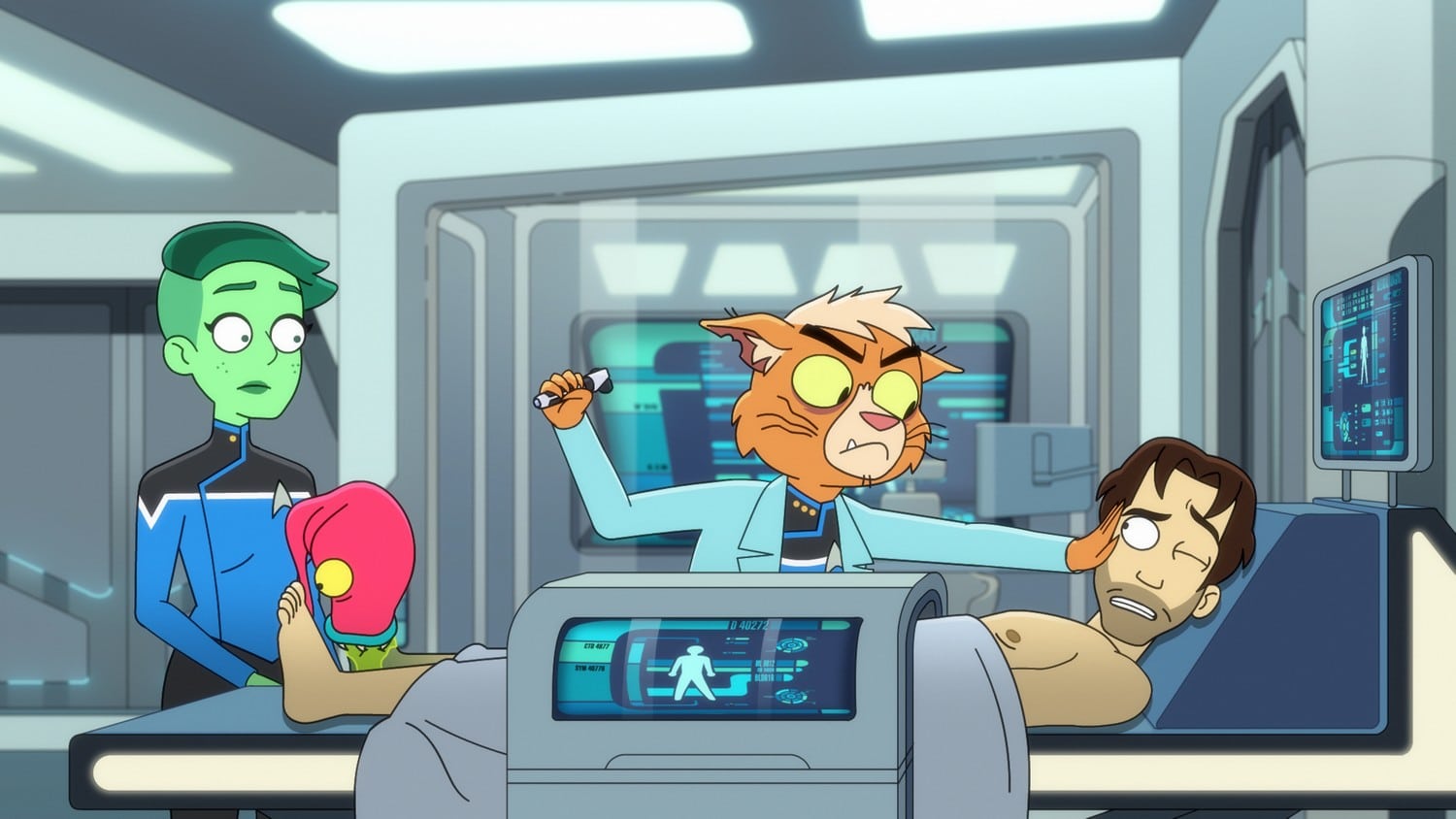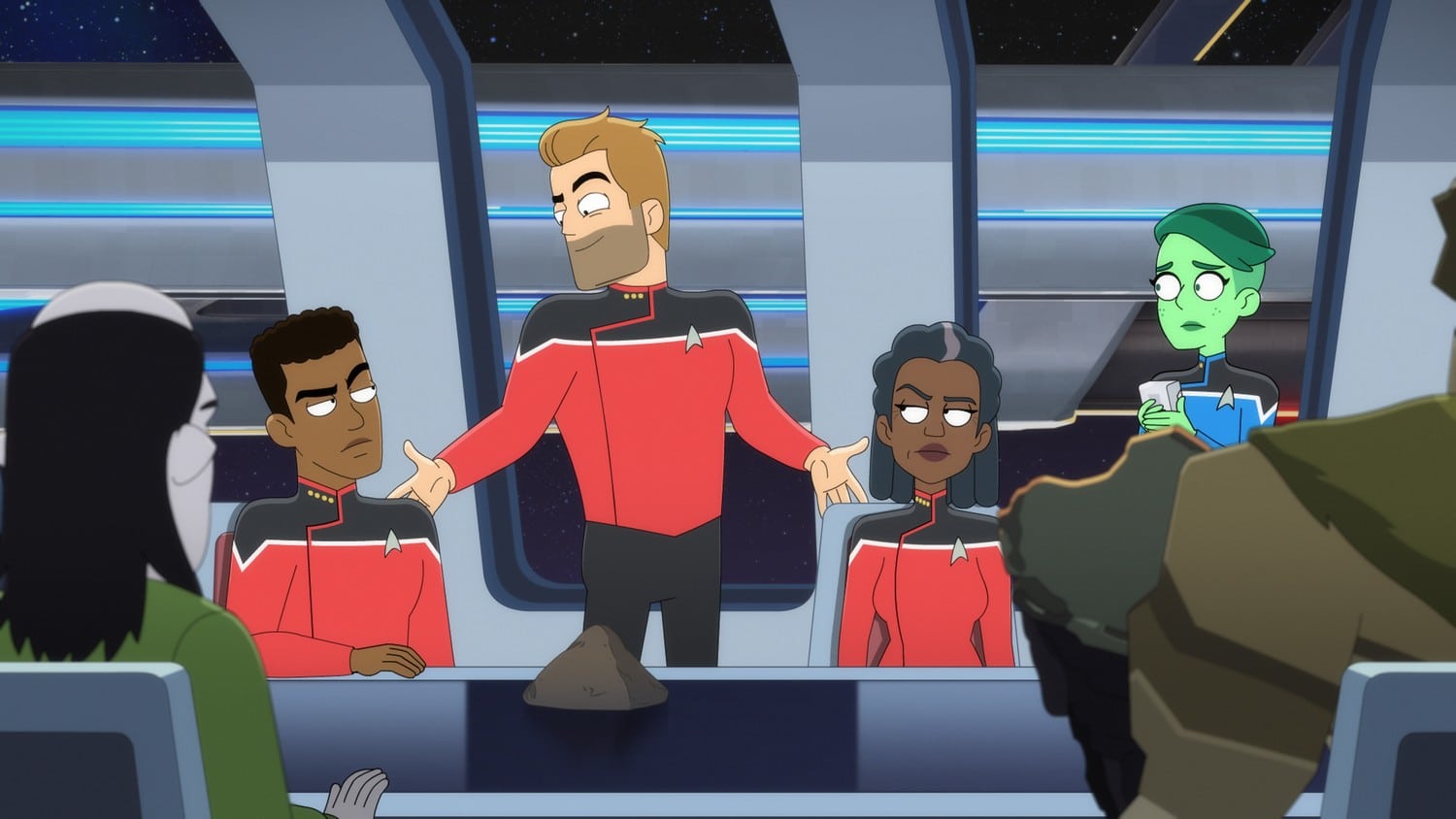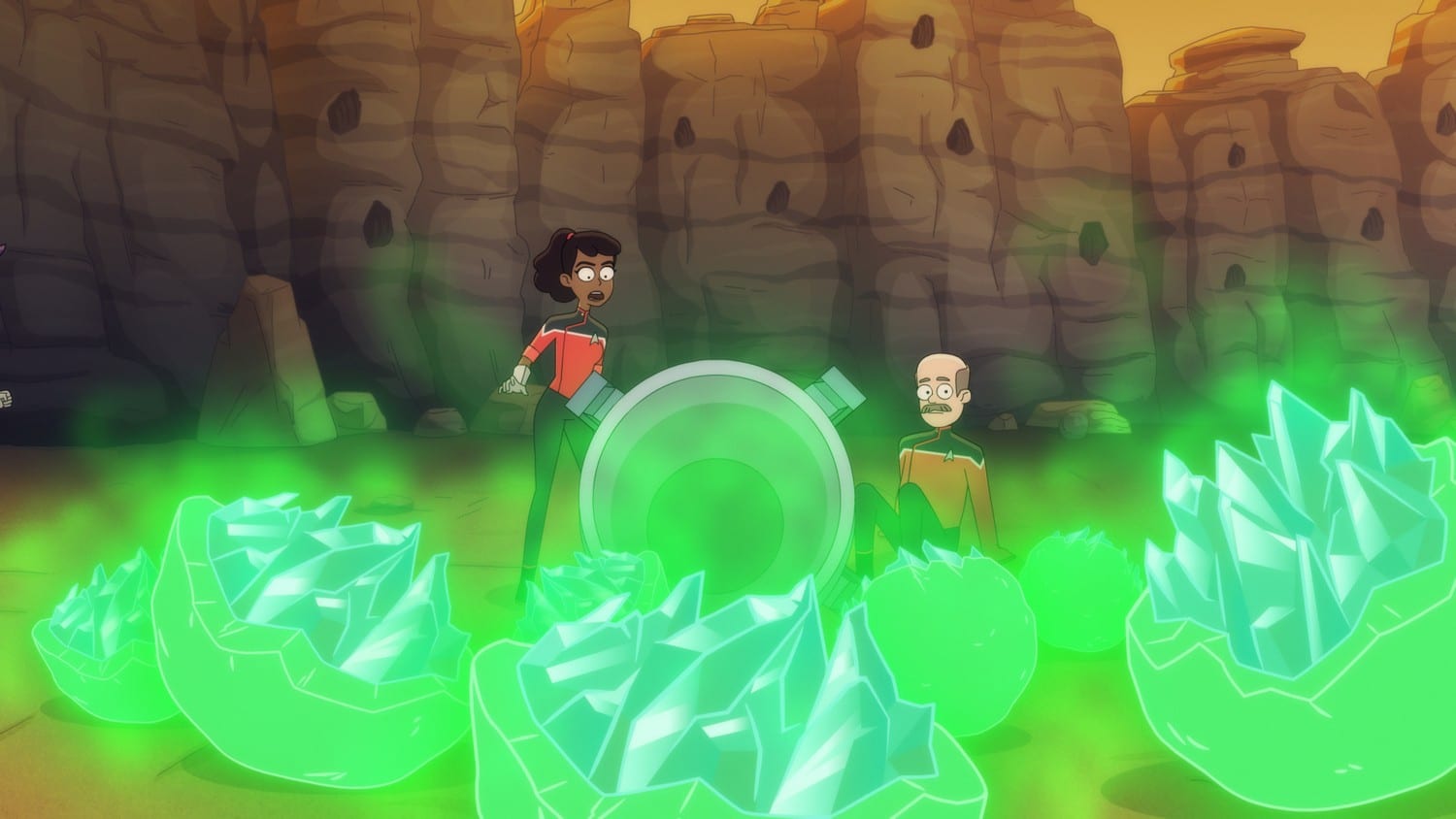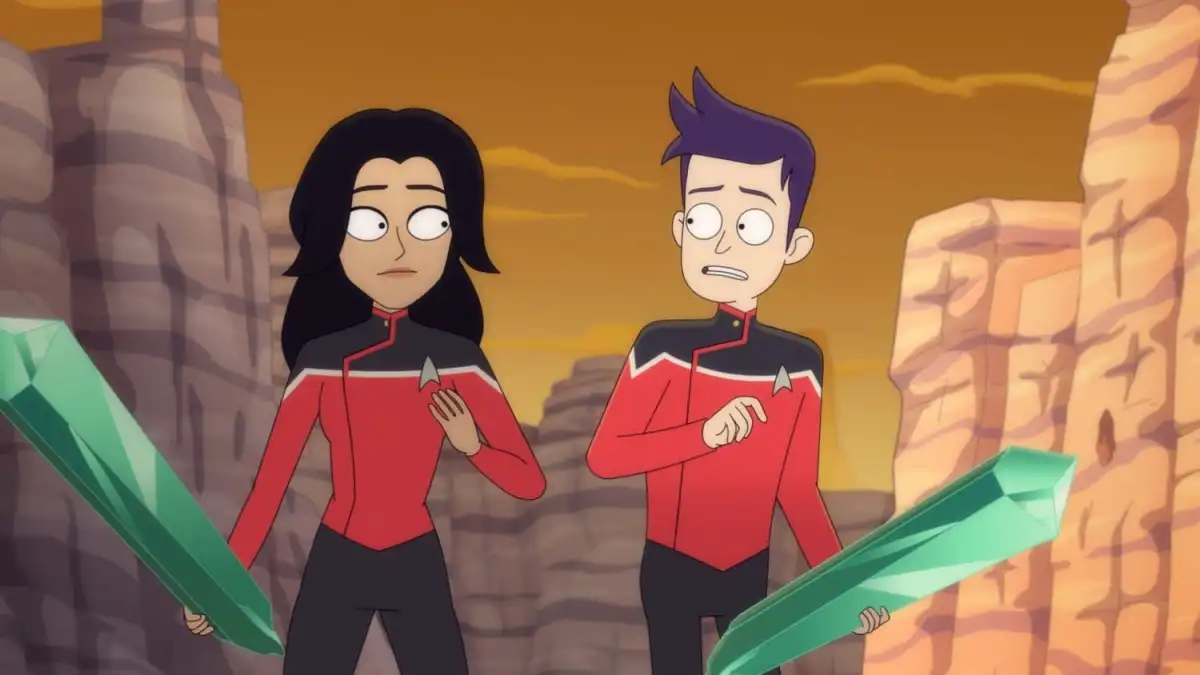This discussion and review contains spoilers for Star Trek: Lower Decks episode 3, “Mining the Mind’s Mines.”
There is an irony to Lower Decks. The animated show marks a bold departure from the other Star Trek series, in that it is explicitly a comedy. This seems likely to alienate certain traditionalist Star Trek fans, who take the franchise very seriously. However, underneath that playful and superficially irreverent surface, there is a convincing argument to be made that Lower Decks is the most staunchly traditionalist of the current wave of Star Trek shows.
Obviously, Lower Decks is built around comedic riffs on familiar Star Trek plots. “Grounded” played on the idea of the crew going rogue. “The Least Dangerous Game” blended a pleasure planet plot with a tale about alien hunters and a specific homage to “Rise.” Even “Mining the Mind’s Mines” is built around the familiar “siren” stories — episodes about hallucinatory space phenomena like “The Man Trap,” “That Which Survives,” “Where No One Has Gone Before,” and “Persistence of Vision.”
However, if one looks past the punchlines and gags, Lower Decks tells stories that are similar in content, structure, and outlook to those featured on the Berman-era Star Trek shows, like The Next Generation, Voyager, and Enterprise. Earlier this year, some traditionalist Star Trek fans argued that Strange New Worlds was “the only recent installment in the franchise that is actually a Star Trek show,” but even using that narrow and nostalgic metric, Lower Decks is much more satisfying.
“Mining the Mind’s Mines” unfolds across two parallel plot threads, adhering to the classic A-plot/B-plot structure that defined so much classic television. One of these two threads focuses on Ensign D’Vana Tendi (Noël Wells) as she embarks upon training to become a senior officer. Along the way, she suffers a crisis of confidence. However, after talking to a senior officer, she rallies herself and proves that she can make the sort of bold decisions that Starfleet needs from its high-ranking officers.

This plot will sound familiar to any Next Generation fan. The show employed a couple of variations on it, featuring a few different characters, often as secondary plots. Wesley Crusher (Wil Wheaton) had a similar arc in “Pen Pals,” when he was placed in charge of a science team. Data (Brent Spiner) learned the same lesson when placed in command of the USS Sutherland in “Redemption II.” Deanna Troi (Marina Sirtis) studies to become a bridge officer in “Thine Own Self.”
Critic Josh Marsfelder argued that one of the key ways of understanding The Next Generation was that it was “children’s television for adults,” that it was a vehicle for allegorical and metaphorical storytelling that could help its audience learn important life lessons. After all, that was largely the arc for characters like Data, who would navigate the depth and breadth of the human experience. To a certain extent, Lower Decks returns to this model of storytelling.
Over the course of “Mining the Mind’s Mines,” Tendi learns to trust in and assert herself. Doctor Migleemo (Paul F. Tompkins) pushes Tendi into a high-profile situation that she isn’t prepared to handle. Insisting that she must learn to be “the voice of science,” Migleemo assigns Tendi to shadow Captain Freeman (Dawnn Lewis). “Tendi, does it matter how much you know if nobody is listening?” he offers by way of justification for his frankly reckless decision.
Tendi has a disastrous experience. She retreats from Freeman’s side, running to Doctor T’Ana (Gillian Vigman) in Sickbay. She confesses that she may not be up to the task. “Of course you’re cut out for it; that’s why I recommended you,” T’Ana responds. “Studying’s good, but in real life, there’s gonna be times when you need to make a mess of things before you can fix them.” She explains, “You’ll be a great officer on the bridge one day, but you’re gonna have to risk screwing things up to get there.”

This is an important life lesson. It’s a necessary part of growing up. There are undoubtedly audience members, both old and young, who can empathize with Tendi’s anxieties and who will respond to T’Ana’s advice. Tendi returns to Freeman’s side, empowered by her mentor’s words, and makes a breakthrough that exposes a sinister plot that could otherwise have posed a real risk to Federation security. It’s a simple and straightforward character arc, but it works.
More than that, it feels close in spirit to what audiences who grew up with The Next Generation loved about it. Strange New Worlds offers a number of very direct and very overt homages to earlier Star Trek stories, to the point that something like “Children of the Comet” is essentially a remake of “Fight or Flight.” However, episodes like “Lift Us Where Suffering Cannot Reach” and “The Serene Squall” would often trip over themselves to avoid saying anything actually meaningful.
It helps that Lower Decks probably has a stronger grasp of characterization than any of the other contemporary Star Trek shows, certainly since the end of the first season of Discovery. Tendi’s arc here is a surprise to her, but it works in the larger context of the character that the audience has watched in earlier episodes like “Grounded,” a character who does have a natural aptitude for command hidden beneath her timid and nerdish exterior.
This carries over to the episode’s other plot. Mariner (Tawny Newsome), Boimler (Jack Quaid), and Rutherford (Eugene Cordero) are assigned to clean up psychic mines on a planet surface. While there, they find themselves in a stand-off with the support crew from another California-class ship, the USS Carlsbad. A rivalry develops between the two teams, stoked by Mariner’s insecurities. As a result, Lieutenant Commander Steve Stevens (Ben Rodgers) accidentally detonates all the mines.

Initially, it seems like the Carlsbad crew members are resentful of their colleagues. “We’ve heard about how you do things on the Cerritos,” Kearns (Kari Wahlgren) states. “We’re not here to screw around.” Rutherford wonders, “Do we have a reputation?” Eventually, it becomes clear that the Carlsbad crew is feeling insecure. “The tales of your exploits are widely shared,” explains Kor-Dee (TBD). “The Cerritos is, in fact, the coolest.” Kearns admits, “The Cerritos is like the Enterprise of the support ships.”
As with Tendi’s plot, this feels very much like a teachable moment. It is a reminder that even people who can seem antagonistic might have a different perspective and that not all professional or personal awkwardness is rooted in animosity. Naturally, the two crews come to bond with one another. Mariner admits that she was insecure about the Carlsbad. The episode ends with the two groups sharing a drink in a joint celebration. It’s another simple arc, but it works.
This is all classic Star Trek stuff. It is a workplace comedy riff on the basic concept of “The Devil in the Dark,” an episode suggested by the presence of silicon-based lifeforms. There’s nothing majorly wrong with this. The most biting criticism that could be made of “Mining the Mind’s Mines” is that its plot and character arcs feel overly familiar and broad. It’s a criticism that doesn’t seem quite so harsh after 10 episodes of Strange New Worlds doing this, except slower and more self-serious.
There are other small and charming details. The nightmares are all goofy and fun, including the Killer Klown Klingons from Outer Space with Bat’leths for arms and the Borg snake that shoots basketball. It’s a nice character touch that Mariner’s greatest nightmare is that Jennifer (Lauren Lapkus) might want to “settle down” with her. There’s also something vaguely timely in a sinister plot about an ornament being used “to collect and sell sensitive Starfleet intelligence on the black market.”
If there is another criticism to be made of “Mining the Mind’s Mines,” it is that the episode is perhaps too earnest. “The Least Dangerous Game” had a bit of fun in its closing scene with Boimler learning the wrong lesson from his adventure and Mariner pushing back on the lesson Ransom (Jerry O’Connell) tried to teach, while “Mining the Mind’s Mines” plays it all just a little too straight. Still, there are certainly worse problems to have.






Published: Sep 8, 2022 11:30 am